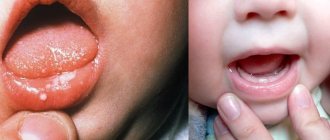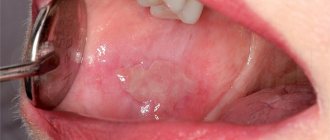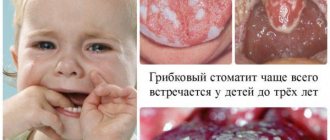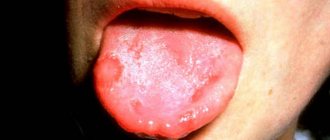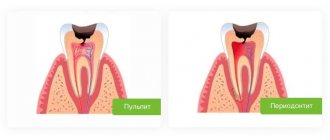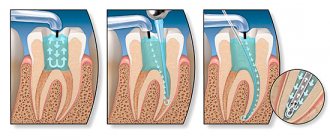Bubbles with yellowish contents on the mucous membrane of the cheeks, back of the tongue, and lips cause pain to the baby and are accompanied by drooling and low-grade fever. Active children become lethargic, sleep restlessly, and are capricious. This is how herpetic stomatitis manifests itself - damage to the mucous membrane provoked by the type I herpes virus. The disease is not dangerous if treated correctly. In the absence of medical supervision or self-medication, the symptoms disappear, but a chronic form may develop, laryngitis, and conjunctivitis may develop.
Herpetic stomatitis in children: general information
Children from six months of age to 5 years are most vulnerable to infection. By 6 months, the protective antibodies received from the mother are gradually eliminated, and one’s own immunity is still weak. The virus is transmitted from parents through licked nipples and spoons, and kisses.
Herpetic stomatitis in a 2-year-old child appears during the first active contacts with children. Infection occurs through toys and dirty hands. At 3–6 years old, the child goes to kindergarten, attends clubs and sections. Adaptation to a team, stress, psycho-emotional tension weaken the immune system. Therefore, acute herpetic stomatitis (AHS) in pediatric dentistry is the leader among inflammations of the oral cavity.
In addition to weak immunity, the development of stomatitis is facilitated by:
- Failure to comply with hygiene rules.
- Hypothermia and overheating.
- Damage to the mucous membrane.
- Past ENT diseases, ARVI.
- Poor diet and vitamin deficiency.
Herpes stomatitis in children is a serious illness that requires immediate medical attention.
You probably know that more than 90% (and according to some sources, all 98%) of the population of our planet are carriers of the herpes virus. Most people live their lives and have no idea about it; for some, the presence of herpes manifests itself only as watery, quickly passing ulcers on the lips during a cold.
But for some, this harmful virus can bring a lot of trouble - genital herpes, herpes zoster, postherpetic neuralgia and herpes stomatitis, which also happens in children. Children under 3 years of age are more likely to get sick, and acute herpetic stomatitis in children . This is a rather serious disease that requires immediate medical intervention, as it has a complex course and is accompanied by a high fever - up to 40°, which is dangerous for young children due to possible seizures and other complications.
Manifestation of herpes stomatitis
Parents are interested in how herpes manifests itself in the mouth, how to distinguish it from other inflammatory diseases and how to treat viral stomatitis . The disease begins with a catarrhal period, when bright red spots appear on the gums, inside the cheeks and lips, causing obvious discomfort to the child because they itch and tingle. If older children immediately draw the attention of their parents to this pathology, then the children simply become irritable, whiny, and stop eating. In children, the temperature rises almost immediately, so the onset of herpes stomatitis is often mistaken for a sore throat or acute respiratory viral infection and the moment of starting treatment for stomatitis is missed. A day later, whitish bubbles appear in place of the spots, which burst and turn into ulcers, which are very painful for the baby. At the same time, enlargement of the lymph nodes is often observed, there may be vomiting, dyspeptic symptoms - diarrhea, rumbling in the abdomen.
Treatment of herpes stomatitis
In acute cases of herpes stomatitis, hospitalization of the child is almost always indicated. If the course of the disease is mild and is not accompanied by fever or other complications that can only be determined by a doctor, treatment at home is possible. In this case, the sick child should be isolated as much as possible from other family members so as not to infect them too. If a diagnosis of herpetic stomatitis in children is established, treatment has some features than for other types of stomatitis. Firstly, this is a local treatment - rinsing with antiseptic solutions (to prevent secondary infection of erosions) using a solution of pimafucin, sage or chamomile decoctions. Children over 1 year old can treat their mouths with propolis, which gives very good results.
How to quickly cure stomatitis in a child under 1 year old - in the article “Treatment of stomatitis in infants. In any case, a course of acyclovir (Zovirax) will be prescribed to lubricate the gums and tongue, for older children - in the form of tablets, after which keratoplasty is prescribed - substances that actively restore damaged oral mucosa - vitamin A, sea buckthorn or rosehip oil, Vinylin ointment . So that the baby can eat - before eating, you can lubricate the painful areas with Baby Doctor ointment, Kalgel, etc. as prescribed by the doctor. At the same time, a course of vitamins and immunomodulators is prescribed to improve immunity. If herpes stomatitis is detected on time and appropriate treatment is prescribed, it is completely cured (but the herpes virus remains in the body forever).
Symptoms of herpetic stomatitis
The severity of acute syndrome is determined by the combination of the severity of mucosal lesions and general symptoms (fever, headache, vomiting). With herpetic stomatitis, there is no transition from stage to stage - either immediately mild, severe, or moderate. In children, general symptoms prevail over local ones; even with minor inflammation of the mucous membrane, low-grade fever and weakness are observed.
Mild form of OGS. The rash is preceded by a rise in temperature to 37.5°C. After 1–2 days, catarrhal gingivitis develops (swelling, darkening, bleeding in the gingival margin). Salivation increases, and the submandibular lymph nodes may enlarge. Against the background of inflammation of the gums, bubbles (up to 3-5 pieces) appear in the mouth, which quickly open and turn into small ulcers with a white coating and reddened edges. Herpetic stomatitis on the tongue causes pain when talking, chewing, children refuse to eat. The rash appears once. After 1–2 days, the temperature returns to normal, swelling of the gums, pain and burning in the mouth decrease. Erosion heals without scars within 5–7 days.
Moderate degree of AHS. The onset of the disease is indicated by a slight increase in temperature, physical malaise, soreness and hardening of the submandibular and cervical lymph nodes. After a day or two, the part of the gum surrounding the teeth swells, turns red and aches, and the temperature rises to 38℃. On the reddened mucous membrane of the mouth and the skin of the perioral area, blisters appear in the amount of 5–15 pieces; they can unite into large painful ulcers with pink outlines and reappear. How long it takes for a child to get herpetic stomatitis depends on immunity, timeliness and effectiveness of treatment. Typically, the peak period of the disease lasts 7–10 days. Without adequate treatment, a herpetic infection can spread to the conjunctiva of the eyes, and ulcerative gingivitis with bleeding erosions, damage to the oropharynx, and deformation of the gingival papillae can develop.
Severe form of OHS. It develops rarely, in most cases in children with immunodeficiency. Already at the beginning of the disease, the lymph nodes in the neck and under the jaw become inflamed, and the temperature rises to 40℃. The swollen mucous membrane bleeds; after a day, bubbles form in the oral cavity, near the lips. New rashes appear repeatedly, you can see a vesicular rash at different stages of healing, merging erosions. Recovery is long (14 days or more), herpetic stomatitis can become recurrent and periodically worsen.
If you notice a rash in your child’s mouth or lips, sign up for a consultation. Our pediatric dentists and periodontist will find a common language with the little patient and quickly alleviate the condition.
Is stomatitis transmitted?
Allergic stomatitis
– one of the most common and intractable types of the disease.
The cause is an allergy, but what exactly is allergy is to be determined first. Allergens can be both food and medicine, as well as materials for dentures installed in the oral cavity. The typical course of stomatitis - the occurrence of painful ulcers - can be further complicated by difficulty breathing and swallowing, typical of allergies. Allergic stomatitis is not transmitted
except through hereditary means.
Viral (herpetic) stomatitis
- another popular type of this disease, especially common in small, close groups of people (schools, kindergartens, work groups, camps).
Its cause is the herpes virus, and its features are erosive spread (others may appear next to one ulcer) and the possibility of severe complications with fever, nausea, vomiting and diarrhea. This is the most contagious variety; in 80% of cases, this stomatitis is transmitted both by airborne droplets and by contact
.
Aphthous stomatitis
– most often occurs in adults, and is associated with weakened immunity.
That is why outbreaks of aphthous stomatitis occur mainly in spring and autumn. It is characterized by the formation of aphthae - small ulcers, both single and occurring in clusters. This stomatitis is not contagious
and cannot be passed on to other people.
Fungal stomatitis (candidomycosis)
– is characteristic of both children (mainly infants) and adults, and mainly women.
It occurs due to Candida fungi, which multiply in the mouth due to weakened immunity or long-term use of antibiotics. It is characterized, in addition to the formation of ulcers, by a white “curdled” coating on the tongue, palate and inner surface of the cheeks. This stomatitis is contagious
: it can be transmitted through direct contact or through household and hygiene items (towel, toothbrush, dishes). A pathogenic fungus can remain in the body for some time and develop in an environment favorable to it.
Nicotine stomatitis
– as the name suggests, occurs in smokers as a result of a long-term addiction to cigarettes.
Tobacco smoke, affecting the oral cavity, actively promotes the growth of bacteria, and also irritates the palate, the tissues become denser, resulting in the formation of numerous ulcers. This type of disease is especially dangerous: although it is not transmitted to other people
, and generally goes unnoticed for a long time, it can develop into oral cancer.
Treatment of herpetic stomatitis at the “Family Dentist”
Therapy for OHS is complex; in mild to moderate cases, it is carried out at home. The dentist prescribes medications, gives recommendations on nutrition and oral hygiene. The cost of an appointment in our clinic is from 10 rubles.
When herpetic stomatitis is diagnosed in children, the treatment regimen includes:
- Diet. Food should be liquid or semi-liquid (mashed soups, vegetable purees, cereals, jelly, yoghurts, minced meat and fish) at a comfortable temperature. In case of extensive erosions, it is advisable to feed the baby liquid food through a tube.
- Prevention of dehydration. Water balance is maintained with dried fruit compotes, broths, plain water, and a weak rosehip decoction.
- Oral hygiene. To prevent the development of a secondary infection, teeth should be cleaned with a soft brush without paste, and the mucous membrane should be treated with a swab and a warm antiseptic solution. You should rinse your mouth every time after eating.
- Local, general therapy. The drugs are prescribed by the dentist, taking into account the severity of the acute syndrome.
Mild degree. Ulcerations of the mucous membrane are treated 3-4 times a day with a cotton pad or bandage soaked in a solution of chlorhexidine 0.05% or miramistin. If necessary, the doctor prescribes an antiviral ointment. If there is no risk of seizures, antipyretic drugs are not prescribed.
Moderate degree. At the height of herpetic stomatitis, treatment with local antiseptic solutions is supplemented with tableted antiherpetic drugs, if the rash does not begin to dry out on the 2nd–3rd day. Medicines have an effect on the entire body, therefore they are taken only as prescribed by a doctor. The mucous membrane after a viral infection is restored with healing agents with vitamins A, E, and sea buckthorn oil. To reduce pain, lidocaine gel is applied to the mucous membrane 20 minutes before meals.
Severe degree. The dentist refers you to the hospital, treatment is carried out with injectable drugs, immunostimulants, and physiotherapy is prescribed.
To make an appointment at the “Family Dentist” in Minsk, fill out the form or call. You don't have to stand in line with a sick child.
What is stomatitis?
Stomatitis is the most common disease of the oral mucosa, which is accompanied by inflammatory processes of various origins. The term is derived from the Latin word "stoma", which means mouth. From the moment a person is born, his mucous membrane is exposed to influences from the external environment: microorganisms and unwanted mechanical influences that can harm it and cause injury. As a result, the mucous membrane may become inflamed and ulcers may form at the site of damage. Stomatitis occurs in everyone, regardless of the number of years lived, although most often infants and preschool children have to deal with it due to the fact that it is at this time that the mucous membrane is more vulnerable. Treatment of stomatitis in children is a medical problem that must be solved by a doctor.
Methods for treating childhood stomatitis
Parents, faced with the problem of the disease, often do not know what to do and ask the question: “How, in fact, to treat stomatitis in a child and what measures should be taken first?” Below are the main treatment positions that you need to know and adhere to:
- Relieve pain and thereby avoid loss of appetite and lack of sleep.
- Treat the inflamed oral mucosa with special medications. But in no case should you resort to using brilliant green and hydrogen peroxide, which will only worsen the situation and, causing a burn, further injure the mucous membrane.
- Use products that promote wound healing as quickly as possible.
- Take medications designed to strengthen the immune system.
Do not forget that the most important thing is to eradicate the cause of the disease. For this purpose, it is necessary to consult a doctor with your child. Only a qualified specialist can determine the cause of childhood stomatitis, make a correct diagnosis and prescribe the most appropriate treatment. Whereas self-medication does not lead to anything good, only to loss of time, deterioration of the condition, prolonged suffering of the baby and your concern about him.
There is a danger of significantly lowering the child’s immune system if not treated correctly. Therefore, you should carefully observe the condition of the oral cavity and do not neglect visiting a doctor. In this case, stomatitis will not be scary at all and will be easily defeated! The price for treating stomatitis in a child is affordable, and the treatment itself is easy.
Tags: Pediatric dentistry
